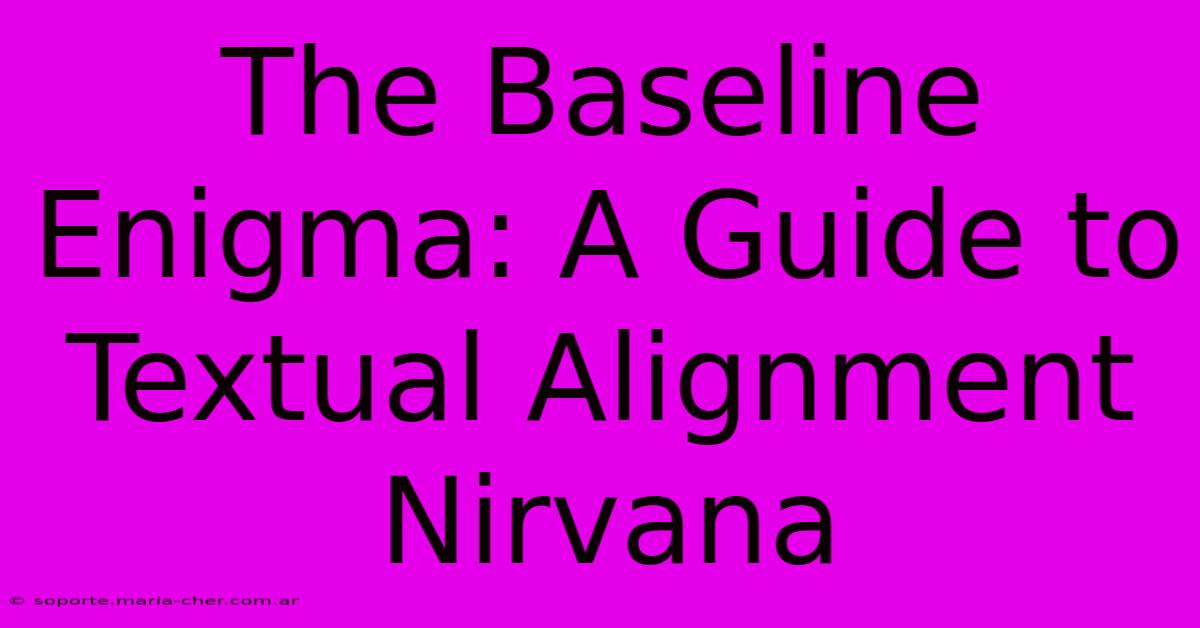The Baseline Enigma: A Guide To Textual Alignment Nirvana

Table of Contents
The Baseline Enigma: A Guide to Textual Alignment Nirvana
Achieving perfect textual alignment can feel like solving a cryptic puzzle. It's the unsung hero of great design, subtly impacting readability and overall aesthetic appeal. This guide unravels the "baseline enigma," offering a comprehensive walkthrough to achieve textual alignment nirvana in your designs. We'll explore the fundamental concepts, common pitfalls, and practical solutions for aligning text effectively across various design contexts.
Understanding Baselines: The Foundation of Alignment
Before diving into techniques, let's establish a clear understanding of the baseline. The baseline is the invisible line upon which text sits. It's the imaginary horizontal line that aligns the bottom of characters, ensuring consistent vertical spacing between lines of text and different font sizes. Mastering baseline alignment is crucial for creating clean, professional-looking designs.
Why is Baseline Alignment Important?
Poor baseline alignment creates a visually jarring effect, making text appear messy and unprofessional. Inconsistencies in vertical spacing can strain readability and distract the viewer from the content itself. Consistent baseline alignment, on the other hand, contributes to:
- Improved Readability: Clean, consistent spacing makes text easier on the eyes and reduces reading fatigue.
- Enhanced Aesthetics: Well-aligned text contributes to a polished and professional overall design.
- Professionalism: Attention to detail, such as baseline alignment, signals competency and care.
Common Baseline Alignment Challenges
Several factors can contribute to baseline alignment issues:
1. Mixing Fonts: The Font Face-Off
Combining different fonts, especially those with varying x-heights (the distance between the baseline and the meanline) and ascenders/descenders (the parts of characters that extend above or below the x-height), can lead to inconsistent baselines.
2. Image and Text Integration: The Spacing Struggle
Integrating images and text requires careful consideration of baseline alignment. Improper spacing can create visual gaps or overlaps, disrupting the flow and readability.
3. Using Multiple Text Sizes: The Size Conundrum
Different text sizes, if not carefully managed, can create uneven vertical spacing, throwing off the baseline alignment.
Achieving Textual Alignment Nirvana: Practical Solutions
Here's how to conquer the baseline enigma and achieve flawless alignment:
1. Embrace Consistent Font Families: The Unity Approach
Using a single font family (or a very closely related set) for your entire project is the simplest way to ensure consistent baselines.
2. Leverage Design Software Tools: The Tech Advantage
Modern design software (like Adobe InDesign, Figma, or Sketch) provides robust tools for precise baseline alignment. Utilize features such as alignment guides, grids, and snapping functionalities to achieve pixel-perfect accuracy.
3. Mastering Vertical Rhythm: The Flow Master
Establishing a strong vertical rhythm through consistent leading (the space between lines of text) is vital. This creates a sense of visual harmony and enhances readability, indirectly improving baseline alignment.
4. Careful Image Placement: The Picture Perfect
When integrating images and text, ensure sufficient spacing to avoid disrupting the baseline alignment. Consider using text boxes and alignment tools to precisely position text relative to images.
5. Test and Refine: The Iterative Process
Always test your designs across different screen sizes and devices. Review the alignment carefully and make adjustments as needed.
Beyond the Baseline: Advanced Techniques
For more complex layouts, consider these advanced techniques:
- Optical Alignment: This involves making subtle adjustments to achieve visually pleasing alignment, even if technically not perfectly aligned on the baseline. It's often crucial for creating a sense of harmony and balance.
- Custom Baseline Grids: For absolute control, create custom baseline grids that define precise vertical spacing across the entire design.
Conclusion: The Path to Perfection
Mastering baseline alignment is a journey, not a destination. By understanding the fundamental concepts, addressing common challenges, and employing the practical solutions outlined in this guide, you'll be well on your way to achieving textual alignment nirvana and creating designs that are both aesthetically pleasing and highly readable. Remember, attention to detail in this area significantly elevates the professionalism and impact of your work.

Thank you for visiting our website wich cover about The Baseline Enigma: A Guide To Textual Alignment Nirvana. We hope the information provided has been useful to you. Feel free to contact us if you have any questions or need further assistance. See you next time and dont miss to bookmark.
Featured Posts
-
Empowering Educators The Role Of Streaming Apps In Building 21st Century Skills
Feb 07, 2025
-
Thread Or Seeds Sewed Vs Sowed The Crucial Distinction
Feb 07, 2025
-
Virginia Heart Attack Hospitalization Costs Brace Yourself For The Shocking Truth
Feb 07, 2025
-
Unveiling The Secret Vermeil Vs Gold Plated Which Reigns Supreme
Feb 07, 2025
-
The Aesthetic Of Decay Gritty Textures For Dramatic Storytelling
Feb 07, 2025
